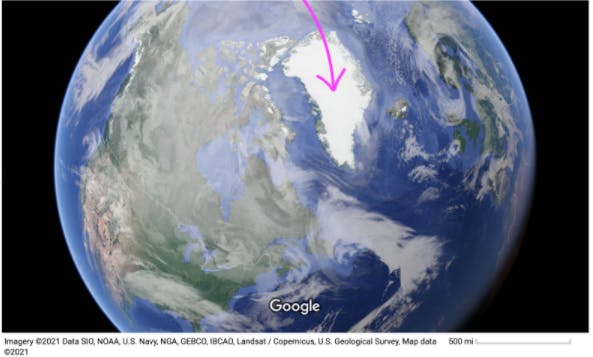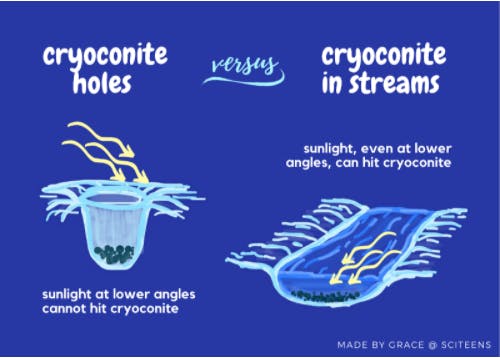Bacteria Melting the Greenland Ice Sheet
By Grace Jiang
January 27, 2021 · 5 minute read
Biology
Earth Science
Environmental Science
In a recent study published in December 2020, researchers detail convincing evidence that bacteria play a crucial role in exacerbating the Greenland Ice Sheet's melting. This study is “the first of its kind,” and its discoveries could prompt changes in current climate change models.
What is the Greenland Ice Sheet?
Before we dive head-first into the specifics of the study, let’s take a look at what the Greenland Ice Sheet is exactly. As its name might suggest, the Greenland Ice Sheet is a giant sheet of ice and snow that sits on the island of Greenland. Here’s a satellite image of what it looks like chilling (and I suppose it is quite chilly up there) on top of Greenland:

Before the 1990s, this ice sheet was in a type of equilibrium where its mass gained equaled its mass loss. However, in more recent years, it has been losing mass to melting, contributing to sea-level rise. This melting could be problematic, as the Greenland Ice Sheet has the major potential to affect sea level. If completely melted, it would cause the mean sea level to rise approximately 7.4 meters, a height comparable to a two-story house. To put things into perspective, just a 1.5-1.8 meter rise in sea level would render large parts of Miami, Florida uninhabitable.
“Supraglacial stream networks”? “Albedo”? “Cryoconite”?
Meltwater on the surface of the Greenland Ice Sheet causes “supraglacial stream networks'' to form. Supraglacial stream networks are exactly what they sound like: networks of streams on top of glaciers.
Now, ice in the Greenland Ice Sheet isn’t exactly as clean as the ice that comes out of a refrigerator door. Because the glacier ice contains debris, some debris will melt into the streams when the ice melts to form supraglacial streams. Much of this debris becomes “sediment,” or insoluble material that floats around in the streams.
Sediment is darker in color and has a significantly lower albedo than stream water, meaning that it absorbs more light relative to how much it reflects. Because stream sediment absorbs more solar radiation than stream water, it also absorbs more heat, contributing to warmer temperatures that can further melt the surrounding ice. Think about how a black jacket warms up faster in the sun compared to a white one; dark colors tend to have lower albedos.
Another word you might encounter when reading the research study is “cryoconite.” Cryoconite is just a type of sediment. It’s composed of a combination of rock particles, soot, and organic matter. In some patches of ice, embedded cryoconite can cause holes to form on the glacier surface. However, these cryoconite holes do not contribute to glacial melting as much as cryoconite washed into the streams because sunlight cannot hit the cryoconite in holes from as many angles as the cryoconite in streams. Check out the “References/Further Reading” section at the bottom of this article if you’re interested in learning more about these cryoconite holes!

Inconsistencies, speculation, and discovery
Now, let’s go back to the study. By conducting various tests, the researchers had discovered an inconsistency in the particle size of the supraglacial stream sediment. Treated cryoconite samples analyzed in the laboratory had a particle size about 90 times smaller than the cryoconite grain size in field observations.
A 90-times difference is definitely pretty significant, so the researchers knew that something was up. They eventually concluded that the organic components of cryoconite are likely causing it to “flocculate” or group together in clumps. These clumps stay together in flowing water, but they break down during transportation to the laboratory, perhaps due to the organic components' fragility once taken out of their stream environment.
The organic material in cryoconite granules is primarily bacteria. The thin, threadlike structure of some bacteria promotes sediment flocculation, and other bacteria in the sediment produce glue-like substances that further cause sediment particles to stick together. Essentially, bacteria are what caused the stream sediment to clump together in sizes around 90 times greater than the analyzed laboratory sizes.
How does this contribute to glacial melting?
We’ve established that bacteria are causing supraglacial stream sediment to clump together. But how exactly do larger particles of sediment contribute to glacial melting?
Well, larger particles are not as easily moved by currents, so they’re not as easily flushed away by stream movement. Tiny grains of sand certainly are flushed away by water much more easily than larger pebbles. Because they aren’t flushed away and therefore remain on the surface of glaciers, larger sediment particles cause an increase in the amount of sediment covering the Greenland Ice Sheet. More specifically, as the research paper proclaims, “Flocculation‐induced increases in supraglacial sediment cover likely cause the albedo of supraglacial streams to decreases by around 16%.”
With an increase in the amount of stream sediment comes an increase in the amount of heat absorbed due to the sediment's low albedo and dark color (as we established earlier in this article). This means that more sediment on the glacier surface equals a faster melt rate for the glacial ice.
Why is this important?
Because water is a darker color than ice, supraglacial streams already absorb more heat than surrounding ice. As glaciers melt, more sunlight is absorbed because there’s less ice to reflect the sunlight. This causes a chain reaction where melting glaciers = more absorbed sunlight from stream water = a warmer climate = more glacial melting. Of course, current climate change models do account for this.
However, this recent study brings bacteria into the equation, and stream sediment absorbs even more heat than stream water. The role of accumulated sediment on the Greenland Ice Sheet would alter current climate change models. Now, melting glaciers = more absorbed sunlight from both stream water and clumps of sediment = a warmer climate that likely promotes sediment bacterial growth = even more, glacial melting.
It isn’t easy to account for every factor surrounding something as complex as the global climate. Unexpected elements, such as this one, will continue to be discovered. We must be proactive in our efforts if we want to put a cap on the increasing global temperatures.
Read the full research paper here:
https://agupubs.onlinelibrary.wiley.com/doi/10.1029/2020GL088444
Did you enjoy this article?
About The Author
Grace Jiang is currently a senior at Pine View School. She loves many things, the most notable of which being ice cream, harp seals, bubble tea, and (of course!) science. Definitely go contact her at grace@sciteens.org if you have any future article recommendations or just want to discuss life.